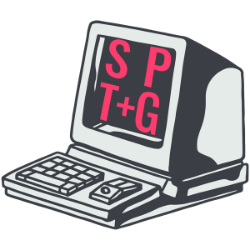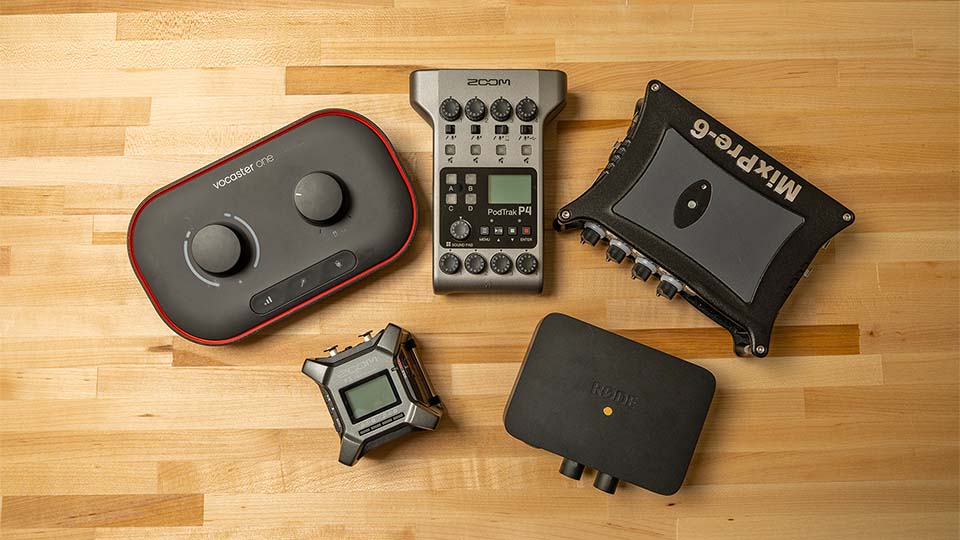Links in this post may be affiliate links. Any products purchased through affiliate links may provide a small commission which helps to support the SemiPro Tech+Gear site and YouTube channel.
Depending on your podcast setup, you may or may not need an audio interface or recorder. If your microphone has a USB connection or if your setup centers around connecting directly to a smartphone or tablet, then you can record without any additional gear. But if you are going with an XLR microphone, then you will need an audio interface or recorder.
One might automatically assume that a USB audio interface is the default choice to pair with an XLR microphone. But for podcasting (or recording video dialog, for that matter), an audio recorder might be a better option. If you are a long-term podcaster, you may decide that owning both types of devices gives you the best flexibility and feature set, but we will approach this from the standpoint of needing to select only one device for now. Let’s consider the pros and cons of both devices and the recording scenarios that they are best for.
Audio Interfaces
USB audio interfaces have come a long way in the last decade, and now there are more devices out there that blur the lines between traditional device categories of interface/mixer/recorder than ever before. One great thing in all this advancement is that today you can get some pretty amazing quality audio hardware for very affordable prices. You can get a very capable audio interface for under $150 (assuming you only need 1-2 XLR inputs) these days. All the interfaces I recommend below are capable of recording in 24-bit depth at 48kHz or higher.
There are a few audio interfaces on the market now that offer features targeted at podcasters (ex: Focusrite Vocaster series), but most are still going to be made for multipurpose use, meaning they have features for recording dialog and musical instruments to provide flexibility and appeal to a broad customer base.
Pros & Cons of Audio Interfaces
+ Top-tier audio quality at affordable prices
+ Most/many are class-compliant to work with smartphones & tablets
+ Huge selection to choose from
+ Multipurpose – not just good at capturing dialog, can be used for music as well as general purpose/virtual meetings, and as an external DAC to power headphones or speakers
– Many of the budget options on the market (and even some intermediate ones) offer less than 60db gain on mic inputs, may struggle to power dynamic microphones without a line booster
– Most do not have inputs for mobile phones, but with loopback you can capture computer audio from virtual meetings/calls
– May or may not be portable for travel podcasting, though travel-oriented interfaces are available (I would recommend a recorder instead)
– Most do not have a 3.5mm output for a camera, though you can convert a 1/4 inch TRS output to 3.5mm if you are careful with the output level
Recommended Audio Interfaces
Budget
Rode AI-1

- 1 XLR input
- 60db gain (with firmware update)
- Small / portable
- Simple, straightforward & affordable
- No loopback or other features
Additional Options
Need 2 mic inputs but don’t love the Vocaster? The MOTU M2 is my top choice.
Need 4 mic inputs? The MOTU M6 and SSL 12 are great options, or splurge and go for the Rodecaster Pro 2 which offers 4 XLR inputs and all the podcasting features you could ever need (see the podcast recorders section below).
Need a travel interface? Skip the iRig line and consider one of the audio recorders below. The Zoom F3 is very portable and functions as a USB audio interface as well. If you only need 3.5mm TRS inputs for lavalier microphones, the Rode AI-Micro is a terrific travel companion.
Why no Scarlett series interfaces? I recommended interfaces above that all offer enough gain for dynamic microphones without a line booster. Focusrite Scarlett series and several other options on the market are made of quality components, but offer a maximum of 56db gain which is just barely enough to get a good recording level from low sensitivity dynamic microphones.
Audio Recorders
I’m including two categories of devices under the umbrella of “audio recorders”. What these devices all have in common is that they record high quality audio internally to SD or microSD cards and don’t require a computer. Here’s a quick definition of the two categories of relevant audio recorders for podcasting:
Field recorders tend to be designed for portability (as one might expect with “field” in the name), so they can be terrific for travel podcasting. Some offer built-in microphone capsules so you always have a mic with you, and all will also feature some type of microphone input, either 3.5mm or more commonly XLR. Some also function as a USB audio interface, so they can be used at home with a computer as well as on the go as a standalone recorder.
Podcast recorders may or may not be designed for portability. Some like the Rodecaster Pro 2 are larger than most USB audio interfaces and are designed to be “all in one podcast studios” that don’t leave your desktop, while others like the Zoom Podtrak P4 can fit in a small bag. An advantage of these devices is that they will provide all the functionality you need to record a podcast, including multiple audio inputs, audio effects and processing, routing options, and more. Because of all these features they can be terrific for live-streaming as well.
Pros & Cons of Field Recorders
+ Most are portable – great for travel podcasting
+ Minimal setup due to standalone recording
+ Large selection available at many budget levels
+ Many have line-outputs for sending audio to a camera
+ Some can function as a USB audio interface if needed
+ Many include basic audio tools like high-pass filters, some may include additional processing or effects
– Affordable options tend to have lower-quality mic preamps compared to affordable USB audio interfaces (I’m looking at you, Zoom H series and Tascam DR series)
– Most do not have inputs for mobile phones, so capturing guest audio via phone call is not possible
– Many do not feature loopback or routing options needed for hosting or live-streaming (though my intermediate & pro options below have one or both)
– Battery life may be terrible (I recommend using a USB power bank or AC adapter since podcast recording can be lengthy)
Recommended Field Recorders
Budget
Zoom H1n

- 24-bit recording
- 3.5mm input + built-in mic
- No XLR input
- Max SD card capacity is 32GB
- Compact, but plastic-y
Additional Options
Looking for something more budget-friendly with XLR inputs? The Zoom H4n provides 2 XLR inputs, but is not the best choice for use with dynamic microphones due to lower available gain and somewhat noisy preamps, unless you have a fethead or cloudlifter. It also is limited to a maximum 32GB SD card. It would be a fine choice to use with condenser microphones or if you have a line booster for a dynamic mic (but I’d still recommend saving up for a Zoom F3 instead).
Pros & Cons of Podcast Recorders
+ Purpose-made for podcasting – will generally include more of the necessary features vs. field recorders
+ Generally include more XLR inputs, helpful if you have in-person co-hosts or guests
+ Recently released options have a staggering amount of functionality and quality (ex: Rodecaster Pro 2)
+ Many have line-outputs for sending audio to a camera
+ Generally will include either a TRRS input or BT connectivity for capturing phone call audio
+ Most will function as a USB audio interface and include customizable routing options
– Affordable options may not be capable of 24-bit depth or higher sample rates
– May not include a 3.5mm output for sending audio to a camera
– Though more are available now than even 2-3 years ago, there still are many fewer options vs. field recorders or audio interfaces
Recommended Podcast Recorders
Budget
Zoom Podtrak P4

- 4 XLR inputs + TRRS input
- Very compact/portable
- Enough gain for dynamic mics
- 4 Headphone outputs
- USB interface functionality
- 16-bit / 44.1kHz only








